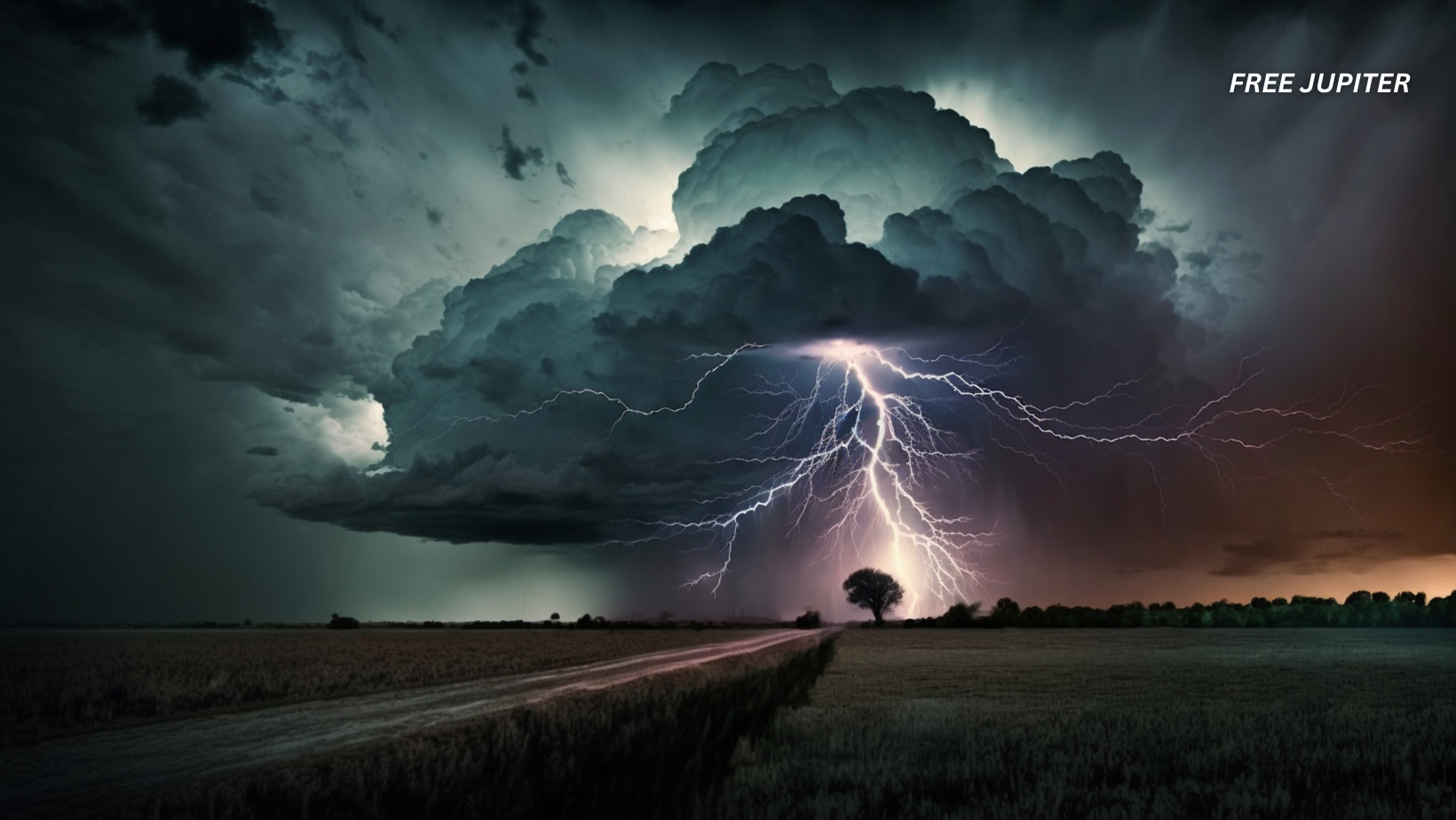Friendly Note: FreeJupiter.com shares general info for curious minds 🌟 Please fact-check all claims—and always check health matters with a professional 💙
Lightning is one of nature’s most stunning performances—sudden, bright, loud, and full of drama. It cracks open the sky, startles the ground below, and vanishes as quickly as it came. But for all its flash and fury, lightning has kept one giant secret: what actually causes it to form in the first place?
Sure, we’ve known the basics for decades—that lightning is a burst of electricity created during a storm—but the fine details have remained surprisingly elusive. Now, a team of researchers believes they’ve finally cracked the code. And no, they didn’t use magic, weather wands, or storm-chasing trucks to do it. They used math.
Yes, math.
A recent study by scientists at Pennsylvania State University dives deep into the world of thunderclouds using high-powered simulations and a new theoretical model that might finally explain how a bolt of lightning begins its life in the sky. And spoiler alert: it all starts with tiny particles gone wild.
A Shockingly Common Mystery
It may surprise you to know that even with our modern tools—weather satellites, climate models, AI prediction systems—we still haven’t fully nailed down how lightning begins. We can track it. We can hear it. We can measure its temperature (hotter than the surface of the sun, by the way). But the trigger? That first electric spark in the sky? That part has been surprisingly fuzzy.
That’s where this new study comes in. By using a combination of advanced computer modeling, field observations, and theoretical physics, the researchers believe they’ve found the chain reaction that sets it all off—one that starts with speeding electrons and ends with a blinding bolt across the clouds.
Read more: Mars’ Glaciers Found to Contain 80% Pure Ice, Redefining The Planet’s Water Reserves
Peeking Into the Heart of the Storm
To figure out how lightning forms, researchers built a simulation that mimics the environment inside thunderclouds. Think of it as a digital thunderstorm, packed with tiny details: wind turbulence, temperature shifts, particle collisions, and of course, electric fields.
The lead scientist, Victor Pasko, an electrical engineer, began crafting this model back in 2023. It wasn’t just guesswork. His team fed in data collected from multiple sources: ground sensors, weather satellites, and even spy planes flying high above thunderstorms (yes, those exist and they’re not just for espionage).
They were especially focused on mysterious bursts of radiation called terrestrial gamma-ray flashes, or TGFs. These are short, invisible bursts of high-energy rays that come from thunderstorms—usually without any visible lightning or thunder to go with them. Strange, right? TGFs were the key clue.
Electrons on the Run
So what’s going on inside these clouds?
The team discovered that when a thundercloud gets agitated (thanks to rising warm air and swirling winds), it builds up powerful electric fields—like the invisible tension between socks fresh from the dryer. These fields are strong enough to accelerate free electrons—tiny negatively charged particles—to incredibly high speeds.
Once they’re moving fast enough, these electrons start crashing into air molecules like nitrogen and oxygen. When that happens, they give off high-energy X-rays, and also knock other electrons loose. Now you’ve got a party of hyperactive particles bouncing around and spreading energy.
This is called an “electron avalanche.” Imagine a snowball rolling down a mountain, picking up more snow until it becomes an unstoppable force. That’s what’s happening here—but instead of snow, it’s electrons, and instead of a mountain, it’s the charged environment of a storm cloud.
Eventually, this electron explosion creates so much electrical energy in one spot that the air breaks down, allowing electricity to shoot through it—zap! That’s lightning.
A Closer Look at Gamma-Ray Flashes
Here’s where things get even more fascinating.
Not every electron avalanche leads to a lightning bolt we can see. Sometimes, the process happens on a smaller scale—just enough to release X-rays or gamma rays, but not enough to make light or sound. These are the TGFs we mentioned earlier.
The new model helps explain why these invisible flashes exist. According to Pasko and his team, these mini-electrical bursts happen in tiny pockets inside the cloud. They’re strong enough to produce radiation, but because the process is uneven and scattered, they often don’t trigger thunder or visible light. Hence, “optically dim and radio silent” TGFs.
This kind of explanation was difficult with older models, which only looked at small slices of thunderclouds and didn’t factor in changes over time. The new model is more dynamic—it simulates the entire process as it unfolds at different altitudes and under different conditions.
That’s a huge leap forward in understanding.
Read more: Investigator Says Mysterious Mars Structures ‘Prove There Was Life’ On The Red Planet
What Makes This Model Different?
One of the biggest improvements here is that the new model is time-dependent. That means it doesn’t just take a snapshot of the storm—it shows the lightning process as it evolves over time, frame by frame.
Previous models were like looking at a still photo of a race car. This one is like watching a high-speed video of the entire race.
Zaid Pervez, a doctoral student involved in the study, explained that this time-based approach allows them to match their simulations more closely to real-world observations. It’s not just theory anymore—it lines up with data from real storms, including TGFs seen by satellites orbiting the Earth.
Why This Matters (Beyond the “Cool Factor”)
Let’s be honest—lightning is fascinating all on its own. But this research isn’t just about satisfying curiosity. It has real-world benefits.
1. Improved Weather Prediction
If scientists can predict when and where lightning might strike based on these particle avalanches, it could lead to better storm warnings and improved safety during severe weather.
2. Safer Air Travel
Airplanes flying near thunderstorms could benefit from real-time alerts about potential lightning activity in the clouds, reducing risks for passengers and crew.
3. New Radiation Sources
Here’s an unexpected twist: the electron avalanches that cause lightning also release intense X-rays in compact bursts. If engineers can harness this mechanism, it could inspire new types of X-ray machines—potentially useful for medicine, materials testing, or even space missions.
It All Comes Back to Simple Ideas
While this research might sound complex—and it is—the foundation is surprisingly simple: start with a basic idea, and build upward.
Just like how recent studies cracked the mystery of static electricity (by analyzing how materials bend and shear when rubbed together), this lightning breakthrough began by asking: What happens when electrons speed up inside a cloud?
From there, the math takes over. Complicated formulas, sure—but driven by an intuitive process: energy builds, particles collide, and nature finds a way to discharge it all in one explosive burst.
Read more: China’s New Levitating Train Can Go From NYC–Chicago in Just Two Hours
Final Sparks: Lightning, Explained
In short, the team’s new theory suggests lightning isn’t so much a random jolt from the sky as it is a carefully choreographed chain reaction—one where electrons go rogue, crash into atoms, and start a runaway firework of energy.
Sometimes, it’s big and bright. Other times, it’s hidden, giving off X-rays in secret flashes we can’t see with the naked eye.
But thanks to clever modeling, grounded science, and a lot of patience, we’re finally getting closer to understanding what lights up the sky during a storm. And if you ask the researchers, that’s only the beginning. There’s still much to learn about what nature hides inside a cloud.










